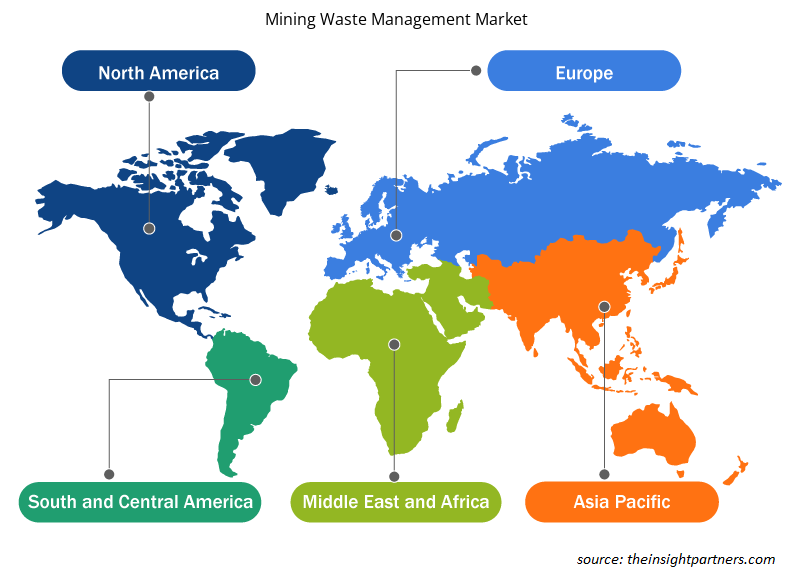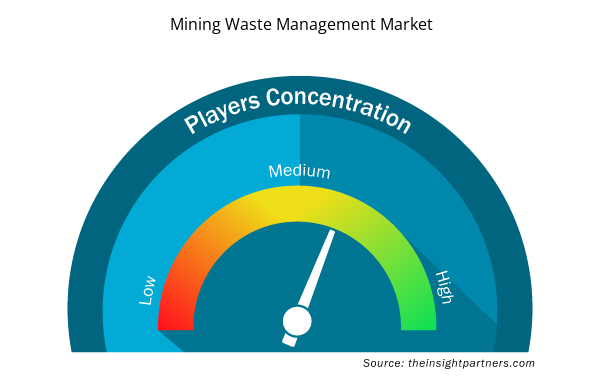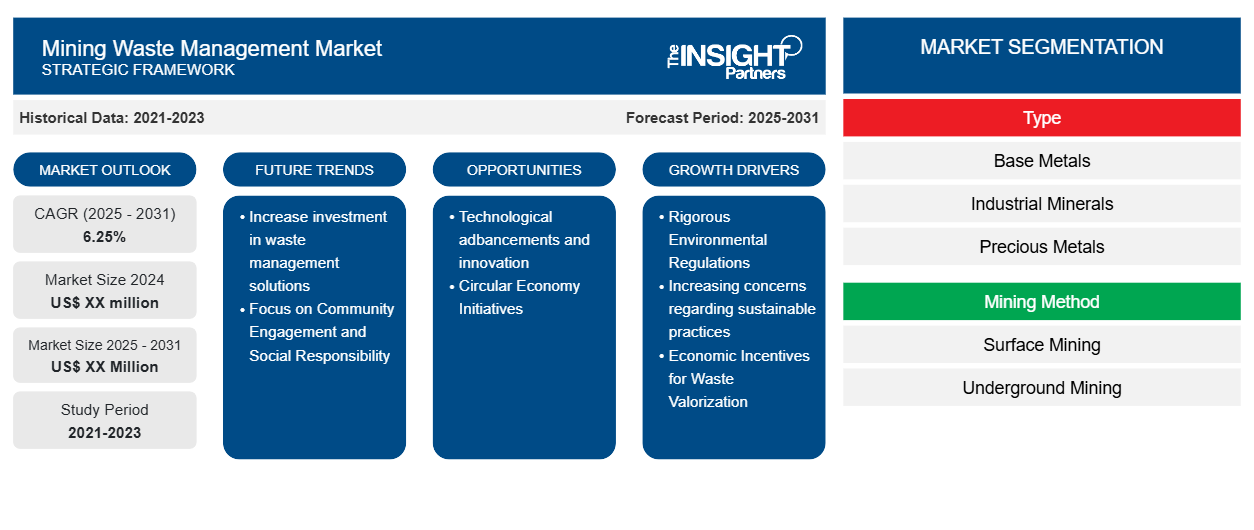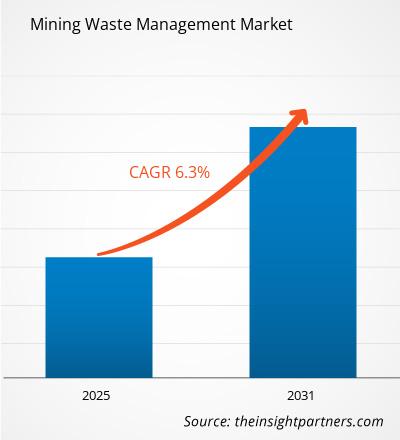Si prevede che il mercato della gestione dei rifiuti minerari registrerà un CAGR del 6,25% dal 2024 al 2031, con una dimensione di mercato in espansione da XX milioni di dollari USA nel 2024 a XX milioni di dollari USA entro il 2031.
Il mercato è segmentato in base a Tipo, Metodo di estrazione e Tipo di rifiuti. Il segmento Tipo è suddiviso in Metalli di base, Minerali industriali, Metalli preziosi, Altri. In base al Metodo di estrazione, il mercato globale della gestione dei rifiuti minerari è segmentato in Estrazione mineraria di superficie, Estrazione mineraria sotterranea. In base al Tipo di rifiuti, il mercato globale della gestione dei rifiuti minerari è segmentato in Tailings, Acqua di miniera, Sovraccarico/Roccia di scarto.
Scopo del rapporto
Il report Mining Waste Management Market di The Insight Partners mira a descrivere il panorama attuale e la crescita futura, i principali fattori trainanti, le sfide e le opportunità. Ciò fornirà spunti a vari stakeholder aziendali, come:
- Fornitori/produttori di tecnologia: per comprendere le dinamiche di mercato in evoluzione e conoscere le potenziali opportunità di crescita, consentendo loro di prendere decisioni strategiche informate.
- Investitori: condurre un'analisi completa delle tendenze in merito al tasso di crescita del mercato, alle proiezioni finanziarie del mercato e alle opportunità esistenti lungo la catena del valore.
- Enti di regolamentazione: regolamentano le politiche e le attività di controllo sul mercato allo scopo di ridurre al minimo gli abusi, preservare la fiducia degli investitori e sostenere l'integrità e la stabilità del mercato.
Segmentazione del mercato della gestione dei rifiuti minerari
Tipo
- Metalli di base
- Minerali industriali
- Metalli preziosi
- Altri
Metodo di estrazione
- Estrazione mineraria di superficie
- Estrazione mineraria sotterranea
Tipo di rifiuto
- Sterili
- Acqua di miniera
- Sovraccarico/roccia di scarto
Geografia
- America del Nord
- Europa
- Asia-Pacifico
- America del Sud e Centro
- Medio Oriente e Africa
Personalizza questo report in base alle tue esigenze
Riceverai la personalizzazione gratuita di qualsiasi report, comprese parti di questo report, o analisi a livello nazionale, pacchetto dati Excel, oltre a usufruire di grandi offerte e sconti per start-up e università
- Scopri le principali tendenze di mercato in questo rapporto.Questo campione GRATUITO includerà analisi di dati che spaziano dalle tendenze di mercato alle stime e alle previsioni.
Fattori trainanti della crescita del mercato della gestione dei rifiuti minerari
- Normative ambientali rigorose: i governi di tutto il mondo stanno imponendo normative severe per controllare i rifiuti minerari e gestire gli effetti ambientali. Per questo motivo, le aziende minerarie stanno adottando misure efficaci per far rispettare migliori pratiche di gestione dei rifiuti che stimolino positivamente la domanda nel mercato della gestione dei rifiuti minerari.
Crescenti preoccupazioni riguardo alle pratiche sostenibili: tutti i tipi di stakeholder, tra cui aziende e investitori, comunità e altri, stanno diventando sempre più consapevoli della necessità di adottare pratiche minerarie sostenibili. Questa crescente consapevolezza sta quindi portando il settore ad adattarsi a metodi efficaci di gestione dei rifiuti che riducono i danni e recuperano più risorse. - Incentivi economici per la valorizzazione dei rifiuti: il potenziale di guadagno dei rifiuti minerari sta innescando nuove idee nella gestione dei rifiuti. Le nuove tecnologie ora consentono alle aziende di ottenere minerali e metalli preziosi dai rifiuti, trasformando ciò che un tempo era una perdita di denaro in una possibile fonte di reddito. Sempre più aziende minerarie stanno utilizzando idee di economia circolare considerando i rifiuti come qualcosa di utile piuttosto che solo spazzatura di cui sbarazzarsi. Opportunità di riduzione dei costi: una gestione intelligente dei rifiuti può ridurre notevolmente i costi a lungo termine, inclusi quelli che le aziende spendono per sbarazzarsi dei rifiuti, ripulendo l'ambiente e affrontando possibili problemi legali.
- Progressi tecnologici e innovazione: le nuove tecnologie stanno causando una rivoluzione nella gestione dei rifiuti minerari. Tecnologie di separazione avanzate: nuove tecniche come la filtrazione a membrana, la biolisciviazione e i processi chimici all'avanguardia stanno migliorando l'elaborazione dei rifiuti. Gli strumenti di monitoraggio basati su intelligenza artificiale e IoT stanno aumentando la produttività della gestione dei rifiuti e aiutando a prevedere le esigenze di manutenzione. Creazione di metodi di estrazione e lavorazione più ecologici che creano meno rifiuti e riducono i danni all'ambiente.
Tendenze future del mercato della gestione dei rifiuti minerari
- Aumentare gli investimenti in soluzioni di gestione dei rifiuti: c'è una tendenza notevole verso l'aumento degli investimenti in tecnologie e servizi di gestione dei rifiuti, in particolare tra le società minerarie. Queste società stanno potenziando in modo proattivo i loro sistemi di gestione dei rifiuti per conformarsi alle pressioni normative e migliorare l'efficienza operativa. Dando priorità a questi investimenti, le società minerarie non solo affrontano le preoccupazioni ambientali, ma ottimizzano anche i loro processi per ridurre i costi e migliorare la sostenibilità nelle loro operazioni.
- Focus su impegno della comunità e responsabilità sociale: oggigiorno, le aziende impegnate nell'estrazione si rendono sempre più conto che le pratiche di gestione dei rifiuti devono essere discusse con le comunità locali. Ciò rappresenta in realtà l'interesse della responsabilità sociale d'impresa, in cui un'azienda lavora per creare fiducia per la comunità locale e mostra la sua preoccupazione per ridurre l'impatto delle sue attività minerarie sull'ambiente locale e sulla popolazione locale
Opportunità di mercato nella gestione dei rifiuti minerari
- Progressi tecnologici e innovazione: alcune delle principali innovazioni tecnologiche includono tecnologie avanzate per quanto riguarda il trattamento e il riciclaggio dei rifiuti. La selezione automatizzata dei rifiuti, la biorisanamento e la conversione dei rifiuti in energia possono rendere le operazioni minerarie molto più efficienti e convenienti, creando al contempo ulteriori opportunità per migliorare la sostenibilità.
- Iniziative di economia circolare: il fenomeno dell'economia circolare consente alle aziende minerarie di ripensare i rifiuti come valore e risorsa. Le pratiche di recupero e riutilizzo, implementate su materiali ricavati dai rifiuti minerari, possono ridurre l'impatto ambientale delle aziende coinvolte nello sviluppo e nel lancio di nuovi flussi di entrate
Approfondimenti regionali sul mercato della gestione dei rifiuti minerari
Le tendenze regionali e i fattori che influenzano il Mining Waste Management Market durante il periodo di previsione sono stati ampiamente spiegati dagli analisti di Insight Partners. Questa sezione discute anche i segmenti e la geografia del Mining Waste Management Market in Nord America, Europa, Asia Pacifico, Medio Oriente e Africa e Sud e Centro America.

- Ottieni i dati specifici regionali per il mercato della gestione dei rifiuti minerari
Ambito del rapporto di mercato sulla gestione dei rifiuti minerari
| Attributo del report | Dettagli |
|---|---|
| Dimensioni del mercato nel 2024 | XX milioni di dollari USA |
| Dimensioni del mercato entro il 2031 | XX milioni di dollari USA |
| CAGR globale (2025 - 2031) | 6,25% |
| Dati storici | 2021-2023 |
| Periodo di previsione | 2025-2031 |
| Segmenti coperti | Per tipo
|
| Regioni e Paesi coperti | America del Nord
|
| Leader di mercato e profili aziendali chiave |
|
Densità degli attori del mercato della gestione dei rifiuti minerari: comprendere il suo impatto sulle dinamiche aziendali
Il mercato Mining Waste Management Market sta crescendo rapidamente, spinto dalla crescente domanda degli utenti finali dovuta a fattori quali l'evoluzione delle preferenze dei consumatori, i progressi tecnologici e una maggiore consapevolezza dei vantaggi del prodotto. Con l'aumento della domanda, le aziende stanno ampliando le loro offerte, innovando per soddisfare le esigenze dei consumatori e capitalizzando sulle tendenze emergenti, il che alimenta ulteriormente la crescita del mercato.
La densità degli operatori di mercato si riferisce alla distribuzione di aziende o società che operano in un particolare mercato o settore. Indica quanti concorrenti (operatori di mercato) sono presenti in un dato spazio di mercato in relazione alle sue dimensioni o al valore di mercato totale.
Le principali aziende che operano nel mercato della gestione dei rifiuti minerari sono:
- Ausenco
- Gestione dei rifiuti Cleanaway Limited
- Gestione dei rifiuti EnviroServ (PTY) Ltd.
- Società di Associati Golder
- Società per azioni Hatch Ltd.
Disclaimer : le aziende elencate sopra non sono classificate secondo un ordine particolare.

- Ottieni una panoramica dei principali attori del mercato della gestione dei rifiuti minerari
Punti chiave di vendita
- Copertura completa: il rapporto copre in modo completo l'analisi di prodotti, servizi, tipologie e utenti finali del mercato della gestione dei rifiuti minerari, fornendo una panoramica olistica.
- Analisi degli esperti: il rapporto è compilato sulla base della conoscenza approfondita di esperti e analisti del settore.
- Informazioni aggiornate: il rapporto garantisce la pertinenza aziendale grazie alla copertura di informazioni recenti e tendenze nei dati.
- Opzioni di personalizzazione: questo report può essere personalizzato per soddisfare le esigenze specifiche del cliente e adattarsi in modo appropriato alle strategie aziendali.
Il rapporto di ricerca sul Mining Waste Management Market può, quindi, aiutare a guidare il percorso di decodificazione e comprensione dello scenario del settore e delle prospettive di crescita. Sebbene possano esserci alcune preoccupazioni valide, i vantaggi complessivi di questo rapporto tendono a superare gli svantaggi.
- Analisi storica (2 anni), anno base, previsione (7 anni) con CAGR
- Analisi PEST e SWOT
- Valore/volume delle dimensioni del mercato - Globale, regionale, nazionale
- Industria e panorama competitivo
- Set di dati Excel



Report Coverage
Revenue forecast, Company Analysis, Industry landscape, Growth factors, and Trends

Segment Covered
This text is related
to segments covered.

Regional Scope
North America, Europe, Asia Pacific, Middle East & Africa, South & Central America

Country Scope
This text is related
to country scope.
Domande frequenti
Ausenco, Cleanaway Waste Management Limited, EnviroServ Waste Management (PTY) Ltd., Golder Associates Corporation, Hatch Ltd., John Wood Group plc, Séché Environnement, Teck Resources Limited, The Weir Group PLC, Veolia Environnement
The report can be delivered in PDF/PPT format; we can also share excel dataset based on the request.
Some of the customization options available based on the request are an additional 3-5 company profiles and country-specific analysis of 3-5 countries of your choice. Customizations are to be requested/discussed before making final order confirmation, as our team would review the same and check the feasibility.
The major factors driving the mining waste managementmarket are: Rigorous Environmental Regulations
The Mining Waste Management Market Size and Forecasts (2021 - 2031), Global and Regional Share, Trends, and Growth Opportunity Analysis Report Coverage:by Type (Base Metals, Industrial Minerals, Precious Metals, Others); Mining Method (Surface Mining, Underground Mining); Waste Type (Tailings, Mine Water, Overburden/Waste Rock) , and Geography (North America, Europe, Asia Pacific, and South and Central America) is estimated to witness a CAGR of 6.25% from 2023 to 2031
Trends and growth analysis reports related to Manufacturing and Construction : READ MORE..
1.Ausenco2.Cleanaway Waste Management Limited3.EnviroServ Waste Management (PTY) Ltd.4.Golder Associates Corporation5.Hatch Ltd.6.John Wood Group plc7.Séché Environnement8.Teck Resources Limited9.The Weir Group PLC10.Veolia Environnement
The Insight Partners performs research in 4 major stages: Data Collection & Secondary Research, Primary Research, Data Analysis and Data Triangulation & Final Review.
- Data Collection and Secondary Research:
As a market research and consulting firm operating from a decade, we have published and advised several client across the globe. First step for any study will start with an assessment of currently available data and insights from existing reports. Further, historical and current market information is collected from Investor Presentations, Annual Reports, SEC Filings, etc., and other information related to company’s performance and market positioning are gathered from Paid Databases (Factiva, Hoovers, and Reuters) and various other publications available in public domain.
Several associations trade associates, technical forums, institutes, societies and organization are accessed to gain technical as well as market related insights through their publications such as research papers, blogs and press releases related to the studies are referred to get cues about the market. Further, white papers, journals, magazines, and other news articles published in last 3 years are scrutinized and analyzed to understand the current market trends.
- Primary Research:
The primarily interview analysis comprise of data obtained from industry participants interview and answers to survey questions gathered by in-house primary team.
For primary research, interviews are conducted with industry experts/CEOs/Marketing Managers/VPs/Subject Matter Experts from both demand and supply side to get a 360-degree view of the market. The primary team conducts several interviews based on the complexity of the markets to understand the various market trends and dynamics which makes research more credible and precise.
A typical research interview fulfils the following functions:
- Provides first-hand information on the market size, market trends, growth trends, competitive landscape, and outlook
- Validates and strengthens in-house secondary research findings
- Develops the analysis team’s expertise and market understanding
Primary research involves email interactions and telephone interviews for each market, category, segment, and sub-segment across geographies. The participants who typically take part in such a process include, but are not limited to:
- Industry participants: VPs, business development managers, market intelligence managers and national sales managers
- Outside experts: Valuation experts, research analysts and key opinion leaders specializing in the electronics and semiconductor industry.
Below is the breakup of our primary respondents by company, designation, and region:

Once we receive the confirmation from primary research sources or primary respondents, we finalize the base year market estimation and forecast the data as per the macroeconomic and microeconomic factors assessed during data collection.
- Data Analysis:
Once data is validated through both secondary as well as primary respondents, we finalize the market estimations by hypothesis formulation and factor analysis at regional and country level.
- Macro-Economic Factor Analysis:
We analyse macroeconomic indicators such the gross domestic product (GDP), increase in the demand for goods and services across industries, technological advancement, regional economic growth, governmental policies, the influence of COVID-19, PEST analysis, and other aspects. This analysis aids in setting benchmarks for various nations/regions and approximating market splits. Additionally, the general trend of the aforementioned components aid in determining the market's development possibilities.
- Country Level Data:
Various factors that are especially aligned to the country are taken into account to determine the market size for a certain area and country, including the presence of vendors, such as headquarters and offices, the country's GDP, demand patterns, and industry growth. To comprehend the market dynamics for the nation, a number of growth variables, inhibitors, application areas, and current market trends are researched. The aforementioned elements aid in determining the country's overall market's growth potential.
- Company Profile:
The “Table of Contents” is formulated by listing and analyzing more than 25 - 30 companies operating in the market ecosystem across geographies. However, we profile only 10 companies as a standard practice in our syndicate reports. These 10 companies comprise leading, emerging, and regional players. Nonetheless, our analysis is not restricted to the 10 listed companies, we also analyze other companies present in the market to develop a holistic view and understand the prevailing trends. The “Company Profiles” section in the report covers key facts, business description, products & services, financial information, SWOT analysis, and key developments. The financial information presented is extracted from the annual reports and official documents of the publicly listed companies. Upon collecting the information for the sections of respective companies, we verify them via various primary sources and then compile the data in respective company profiles. The company level information helps us in deriving the base number as well as in forecasting the market size.
- Developing Base Number:
Aggregation of sales statistics (2020-2022) and macro-economic factor, and other secondary and primary research insights are utilized to arrive at base number and related market shares for 2022. The data gaps are identified in this step and relevant market data is analyzed, collected from paid primary interviews or databases. On finalizing the base year market size, forecasts are developed on the basis of macro-economic, industry and market growth factors and company level analysis.
- Data Triangulation and Final Review:
The market findings and base year market size calculations are validated from supply as well as demand side. Demand side validations are based on macro-economic factor analysis and benchmarks for respective regions and countries. In case of supply side validations, revenues of major companies are estimated (in case not available) based on industry benchmark, approximate number of employees, product portfolio, and primary interviews revenues are gathered. Further revenue from target product/service segment is assessed to avoid overshooting of market statistics. In case of heavy deviations between supply and demand side values, all thes steps are repeated to achieve synchronization.
We follow an iterative model, wherein we share our research findings with Subject Matter Experts (SME’s) and Key Opinion Leaders (KOLs) until consensus view of the market is not formulated – this model negates any drastic deviation in the opinions of experts. Only validated and universally acceptable research findings are quoted in our reports.
We have important check points that we use to validate our research findings – which we call – data triangulation, where we validate the information, we generate from secondary sources with primary interviews and then we re-validate with our internal data bases and Subject matter experts. This comprehensive model enables us to deliver high quality, reliable data in shortest possible time.


 Ottieni un campione gratuito per questo repot
Ottieni un campione gratuito per questo repot